Black Pepper: Diseases and Symptoms
Black Pepper: Diseases and Symptoms
Foot rot /quick wilt disease
Disease symptoms- One or more black spots appear on the leaves which have a characteristic fine fibre like projections at the advancing margins which rapidly enlarge and cause defoliation.
- The tender leaves and succulent shoot tips of freshly emerging runner shoots trailing on the soil turn black when infected. The disease spreads to the entire vine, from these infected runner shoots and leaves, during intermittent showers due to rain splash.
- If the main stem at the ground level or the collar is damaged, the entire vine wilts followed by shedding of leaves and spikes with or without black spots. The branches break up at nodes and the entire vine collapses within a month.
- If the damage is confined to the feeder roots, the expression of symptoms is delayed till the cessation of rain and the vine starts showing declining symptoms such as yellowing, wilting, defoliation and drying up of a part of the vine.

- Fungus survives in disease plant debris as well as soil. These vines may recover after the rains and survive for more than two seasons till the root infection culminates in collar rot and death of the vine.
- Rainy season during October-November onwards favour the development of disease.
Pollu disease /anthracnose
Disease symptoms- It can be distinguished from the pollu (hollow berry) caused by the beetle by the presence of characteristic cracks on the infected berries.
- The disease appears towards the end of the monsoon.
- The affected berries show brown sunken patches during early stages and their further development is affected.
- In later stages, the discolouration gradually increases and the berries show the characteristic cross splitting.
- Finally, the berries turn black and dry. The fungus also causes angular to irregular brownish lesions with a chlorotic halo on the leaves.
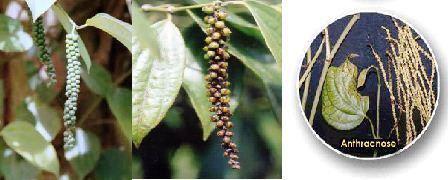
- The primary infection by sowing infected seeds and secondary by wind.
- Rain and high humidity are responsible for the development of disease.
Slow decline /slow wilt
Disease symptoms- Foliar yellowing, defoliation and die-back are the aerial symptoms of this disease. The affected vines exhibit varying degrees of root degeneration due to infestation by plant parasitic nematodes.
- The diseased vines exhibit foliar yellowing from October onwards coinciding with depletion of soil moisture.
- With the onset of south west monsoon during May/June, some of the affected vines recover and put forth fresh foliage.
- The symptoms reappear in subsequent seasons after the cessation of the monsoon and the diseased vines gradually lose their vigour and productivity.
- The affected vines show varying degrees of feeder root loss and the expression of symptoms on the aerial parts occur after a considerable portion of the feeder roots are lost.
- The root system of diseased vines show varying degrees of necrosis and presence of root galls due to infestation by plant parasitic nematodes such as Radopholus similis and Meloidogyne incognita leading to rotting of feeder roots. The damage to feeder roots is caused by these nematodes and P. capsici either independently or together in combination.
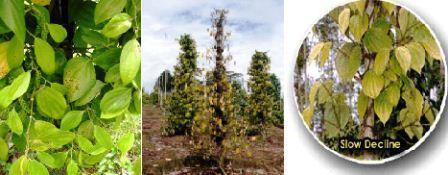
- Fungus survives in disease plant debris.
- Cysts and egg masses in infected plant debris and soil or collateral and other hosts like Solonaceous, Malvaceous and Leguminaceous plants act as sources of inoculums.
- Autonomous second stage juveniles that may also be water dispersed.
- Rainy seasons and loamy light soils favours the development of disease.
Stunt disease
Disease symptoms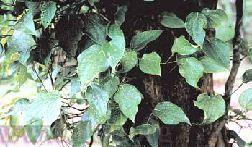 This disease which is caused by viruses is noticed in parts of Kannur, Kasargod, Kozhikode, Wayanad and Idukki Districts of Kerala and Kodagu, Hassan and Uthara Kannada districts of Karnataka.
This disease which is caused by viruses is noticed in parts of Kannur, Kasargod, Kozhikode, Wayanad and Idukki Districts of Kerala and Kodagu, Hassan and Uthara Kannada districts of Karnataka.- The vines exhibit shortening of internodes to varying degrees.
- The leaves become small and narrow with varying degrees of deformation and appear leathery, puckered and crinkled.
- Chlorotic spots and streaks also appear on the leaves occasionally. The yield of the affected vines decreases gradually.
- Two viruses namely Cucumber Mosaic Virus and a Badna virus are associated with the disease.
- The major means of spread of the virus is through the use of infected stem cuttings. The disease can also be transmitted through insects like aphids and mealy bugs.
Phyllody disease
Disease symptoms- This disease which is caused by Phytoplasma is noticed in parts of Wayanad and Kozhikode districts of Kerala.
- The affected vines exhibit varying stages of malformation of spikes. Some of the floral buds are transformed into narrow leaf like structures.
- Such malformed spikes show leafy structures instead of floral buds, exhibiting Phyllody symptoms.
- In advanced stages, the leaves become small and chlorotic, and the internodes are also shortened.
- The affected fruiting laterals give a witches broom appearance. Severely affected vines become unproductive.
- In severely affected vines the entire spike is converted into small branches which appear chlorotic and the vines decline rapidly.
- The infected vine becomes unproductive within two to three years.
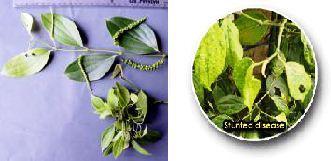
- The infected vines are to be destroyed to prevent the further spread of the disease.
- Phytoplasma disease is spread by leaf hoppers and plant hoppers besides spread by vegetative propagation through cuttings, storage tubers, rhizomes or bulbs.
Basal wilt
Symptoms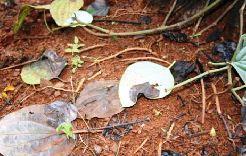 Grayish lesions appear on stems and leaves.
Grayish lesions appear on stems and leaves.- On the leaves white mycelium are seen at the advancing edges of the lesions.
- The mycelial threads later girdle the stem resulting in drooping of leaves beyond the point of infection and in advanced stages the rooted cuttings dry up.
- Small whitish to cream coloured grain like sclerotial bodies appear on the mature lesions.
- Disease is soil born and pathogen survives in soil which is the source of primary infection.
- The disease is mainly noticed in nurseries during June- September and is caused by Sclerotium rolfsii.
Leaf rot and blight
Symptoms- Greyish sunken spots and mycelial threads appear on the leaves and the infected leaves are attached to one another with the mycelial threads.
- Leaf spots caused by Colletotrichum sp. are characterized by yellow halo surrounding the necrotic spots.
- On stems, the infection occurs as dark brown lesions which spread both upwards and downwards. The new flushes subtending the points of infection gradually droop and dry up.
- Disease is soil born and pathogen survives in soil which is the source of primary infection.
- The disease is caused by Rhizoctonia solani Kühn and is often serious in nurseries during April- May when warm humid conditions prevail. The fungus infects both leaves and stems.
IPM for Black Pepper
To know the IPM practices for Black Pepper, click here.
Source: NIPHM and Directorate of Plant Protection, Quarantine & Storage
Last Modified : 12/11/2019
© C–DAC.All content appearing on the vikaspedia portal is through collaborative effort of vikaspedia and its partners.We encourage you to use and share the content in a respectful and fair manner. Please leave all source links intact and adhere to applicable copyright and intellectual property guidelines and laws.
RELATED ITEMS
Black Pepper: Insect and Nematode Pests Management
This topic covers the information related to Insec...
Nutritional Deficiencies/Disorders of Black Pepper
This topic covers the information related to Nutri...
Black Pepper
This topic provides the package of practices for c...
Black Pepper Pests
This topic covers the information related to Pest ...
